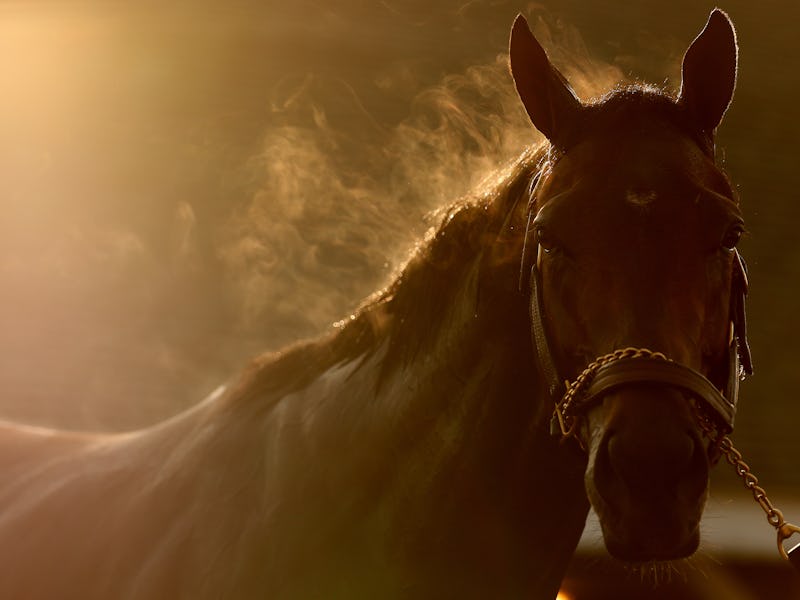Kentucky Derby Race Horses Are a Paradox — Why It's Nearly Impossible to Predict the Winner
What drives a horse’s speed and stamina? Equine experts still aren’t sure.

This Saturday, 20 teenage-brained horses will race in the longest-existing sporting event in American history: the Kentucky Derby.
The contestants are all three years old and their teams have just one shot at winning the prestigious trophy. But for all the millions of dollars and months of nuanced training that go into the sport, racehorses remain a paradox.
Yes, thoroughbred horses are built for speed, and their cardiovascular systems go through intense training. And the horses that run the Kentucky Derby are all around three, when they’re at their physical prime, lingering juvenile mentality aside. But the alchemy of a champion is elusive. They shouldn’t be able to do what they do, one equine specialist tells Inverse.
With favorite horses Epicenter and Zandon dueling in front, Rich Strike came charging up the rail for a stunning 80-1 upset in the Kentucky Derby at Churchill Downs on Saturday, May 7, 2022, in Louisville, Kentucky.
Take for instance the story of Rich Strike. On the first Saturday of May in 2022, long-shot thoroughbred Rich Strike raced from almost dead-last against 19 other horses, winded his way towards an opening on the inside rail, to chase the head of the pack with only the final fourth of the Kentucky Derby racetrack left to spare. Miraculously, Rich Strike passed the two favorites and snatched the trophy.
The achievement, against 80 to 1 odds, highlights the perplexity of the thoroughbred’s indelible spirit and stamina. So what is the secret sauce of horse genetics? Here’s what experts do know.
Why do horses run so fast?
Horses are prey animals. Their musculoskeletal systems are designed for constant motion, and accelerating is critical. But racehorses have lots of opportunities to hurt themselves, too.
Thoroughbred horse Forever Young trains on the track during morning workouts ahead of the 150th running of the Kentucky Derby at Churchill Downs on May 02, 2024 in Louisville, Kentucky.
“They shouldn’t be able to do what they do. There is a fine line of taking a horse that really has evolved to travel long distances relatively slowly or at a medium pace — a walk, a trot — and have their job day in and day out be racing at speed,” Michelle Delco, orthopedic veterinarian for horses and assistant research professor at Cornell University, tells Inverse.
Their muscles, heart, and lungs are powerful. But their bones, which give them a light frame, tend to accumulate micro-injuries. Horse ligaments and tendons are not designed for repeated trauma, but instead, for the occasional mad dash away from predators.
Their feet, in particular, are fragile. “They have a lot of problems with their feet,” Delco says. “But the real thing is training race horses in a way that allows them to build up those tissues that have to be strong and withstand the galloping.”
They run in spite of their flaws, Delco adds.
Anatomy of horse with possible defects in physique, Johannes le Francq van Berkhey, 1739 - 1812.
The equine heart
So what works in their favor? Their hearts, literally and figuratively.
Thoroughbred racehorse hearts can weigh between 10 to 12 pounds. They’ve got high blood volume and efficient muscle fibers. According to Steinbeck Peninsula Equine Clinics, horses circulate greater amounts of oxygen and their muscles use it at a higher rate for longer periods of time, pushing off fatigue.
There’s debate about the emotional side, too. Delco says some racehorses exude confidence, and many genuinely want to win. In the same way a greyhound is driven to chase a rabbit, it’s what a racehorse is designed to do, says Delco. “Some people think race horses are forced to race. It couldn’t be farther from the truth. If they don’t love it, they’re not good at it. It’s what they are born to do.”
But others disagree. Neuroscientist Stephen Peters told The Guardian last year that horses don't think in abstracts; their desire to win is an anthropomorphism, a way in which humans frame the actions of other animals. An example is Rich Strike’s behavior after winning the Derby, when he bit the reins and neck of an outrider pony, perhaps due to adrenaline, perhaps also due to poor human management.
Horse racing is a thrilling and symbolic sport for many people. But although horses have been at our side for thousands of years, there’s still much to learn about what’s in a horse’s spirit.